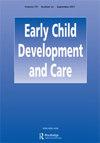Interaction quality in German early childcare settings: investigating the domains of CLASS Toddler and the associations with structural characteristics
IF 1
4区 心理学
Q3 EDUCATION & EDUCATIONAL RESEARCH
引用次数: 0
Abstract
ABSTRACTThe present study examines the quality and domains of teacher-toddler interactions and associations with structural characteristics using data from 95 German early childcare settings. The results of the confirmatory factor analysis supported a two-factor structure of interaction quality assessed by the CLASS Toddler: emotional and behavioural support (EBS) and engaged support for learning (ESL). The EBS domain showed higher quality ratings (M = 5.33, SD = .59) than the ESL domain (M = 3.23, SD = .70). Structural equation modelling was applied to estimate associations between those domains and structural characteristics within classrooms. Structural characteristics predicting interaction quality were teachers' age (for EBS), teachers' education (for ESL) and children's age composition in the classroom (for EBS and ESL). Overall, the two-factor structure of CLASS Toddler could be replicated. For high-quality interactions, teacher and classroom characteristics are crucial but need to be carefully distinguished. Beyond their limitations, these findings have implications that are discussed.KEYWORDS: Early childhood education and care (ECEC)toddler classroomsteacher–child interactionsinteraction qualitystructural qualityclassroom assessment scoring system CLASS Toddler Disclosure statementNo potential conflict of interest was reported by the author(s).Ethics statementThe Ethics Committee of the University of Bamberg approved the project.Additional informationFundingThis work was supported by the German Research Foundation [grant numbers DO 2304/1-1, LE 3245/1-1, LI 3487/1-1, RO 820/18-1, and WE 1478/13-1].Notes on contributorsFranka BaronFranka Baron (from January 2020 to July 2023) was a scientific associate and a PhD-student at the German Youth Institute, Department of Social Monitoring and Methodology. From August 2023she has been a scientific associate at the University of Bern, Interfaculty Centre for Educational Research (ICER).Anja LinbergAnja Linberg (from December 2010 to March 2013) was a scientific associate at the National Educational Panel Study (NEPS), From November 2012 to September 2017 she was a scientific associate at the University of Bamberg, department of elementary and family education. From October 2017 to January 2019: Anja was a PostDoc at the Leibniz Institute for Educational Trajectories (LIfBi), Center of Excellence for Early Childhood Education. Since February 2019 she has been the Head of the Child Competence Team at the German Youth Institute, Department of Social Monitoring and Methodology.Simone LehrlSimone Lehrl (from April 2008 to April 2019) was a scientific associate at the University of Bamberg, department of elementary and family education. From January 2018 to April 2019, Simone was a scientific associate at the University of Bamberg, department psychology I - Developmental Psychology. From May 2019 to December 2021 she was a temporary academic councilor at the University of Bamberg, department of psychology I - developmental psychology. From October 2020 to DDecember 2021 she was a substitute professor for early childhood education at the University of Education Weingarten, Institute of Educational Sciences, sinceJanuary 2022 she has been a professor of early childhood education (W3), University of Education Weingarten, Institute of Educational Sciences.德国早期儿童保育环境中的互动质量:调查CLASS幼儿的领域及其与结构特征的关联
摘要本研究利用德国95个早期儿童保育机构的数据,考察了教师与幼儿互动的质量和领域,以及与结构特征的关联。验证性因素分析的结果支持由CLASS幼儿评估的互动质量的双因素结构:情感和行为支持(EBS)和参与学习支持(ESL)。EBS领域的质量评分(M = 5.33, SD = 0.59)高于ESL领域(M = 3.23, SD = 0.70)。应用结构方程模型来估计这些领域与教室结构特征之间的关联。预测互动质量的结构特征是教师年龄(EBS)、教师受教育程度(ESL)和儿童在课堂上的年龄构成(EBS和ESL)。总体而言,幼儿班的双因素结构具有可复制性。对于高质量的互动,教师和课堂特征是至关重要的,但需要仔细区分。除了它们的局限性之外,这些发现还具有讨论的意义。关键词:幼儿教育与护理(ECEC)幼儿课堂师生互动互动质量结构质量课堂评估评分系统班级幼儿披露声明作者未报告潜在利益冲突。伦理声明班贝格大学伦理委员会批准了该项目。本研究由德国研究基金会支持[资助号:DO 2304/1-1, LE 3245/1-1, LI 3487/1-1, RO 820/18-1和WE 1478/13-1]。franka Baron(从2020年1月至2023年7月)是德国青年研究所社会监测和方法系的一名科学助理和博士生。自2023年8月起,她一直在伯尔尼大学教育研究中心(ICER)担任科学助理。Anja Linberg(2010年12月至2013年3月)是国家教育小组研究(NEPS)的科学助理,2012年11月至2017年9月,她是班贝格大学小学和家庭教育系的科学助理。2017年10月至2019年1月,Anja在莱布尼茨教育轨迹研究所(LIfBi),幼儿教育卓越中心做博士后。自2019年2月以来,她一直担任德国青年研究所社会监测和方法论部儿童能力小组组长。Simone Lehrl(2008年4月至2019年4月)是班贝格大学小学和家庭教育系的科学助理。2018年1月至2019年4月,Simone在班贝格大学心理学系(发展心理学)担任科学助理。2019年5月至2021年12月,她担任班贝格大学心理I系发展心理学临时学术顾问。自2020年10月至2021年12月,她担任Weingarten教育大学教育科学研究所幼儿教育代教授,自2022年1月起担任Weingarten教育大学教育科学研究所幼儿教育(W3)教授。
本文章由计算机程序翻译,如有差异,请以英文原文为准。
求助全文
约1分钟内获得全文
求助全文

 求助内容:
求助内容: 应助结果提醒方式:
应助结果提醒方式:


